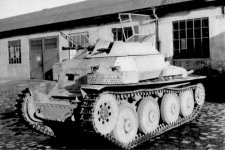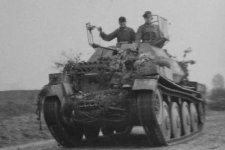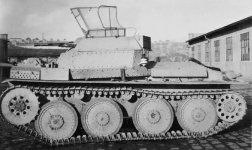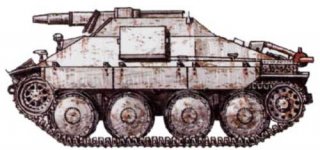wayne556517
Lieutenant General
- Joined
- Aug 28, 2007
- Messages
- 16,243
With the constant need to provide better protection and mobility for the reconnaissance troop a fascinating but rare conversion was made of the existing Czechoslovakian Skoda made Pz.Kpfw.38(t) tank chassis to create the slightly peculiar looking Aufklärungspanzer 38(t) Sd.Kfz.140/1 (reconnaissance-tank).

The Aufklärungspanzer was developed as a primary reconnaissance vehicle proposed to replace both the existing half-tracked and wheeled armoured cars currently engaged in the role of armoured reconnaissance, both of which struggled to cope with the poor conditions experienced of the Russian front. Fitted with the ‘Hangelafette turret’ which hung mounted a 20mm KwK 38 L/55 cannon and an MG42 capable of both anti aircraft and a ground fire role, a mount that was already employed as standard practice in armoured cars and tracked reconnaissance vehicles such as the Sd.Kfz.222 & Sd.Kfz.250/9 and both of which were already fielded in combat operations on the Eastern front. Approximately 70 Aufklarungspanzer 38(t) vehicles armed with the 20mm gun and stowage for some 180 rounds of AP ammunition and a crew of 3 were converted from old stocks of the Panzer 38t (already pulled from front line operations) and refitted from late 1943 to early 1944. This amounted in essence to stripping down the upper hull superstructure of the now obsolete Pz.Kpfw.38(t) and reconfiguring a boxed upper hull structure to fit round the Hangelafette turret. With such relatively small numbers and no future deliverers to come it would seem reasonable to assume that further production was halted in favour of the new Jadgpanzer 38(t) which used up to 80% of the production components allocated to the Pz.Kpfw.38(t) series, presumably making further Aufklärungspanzers impossible to deliver considering other chassis commitments. Another variant on the 38(t) chassis which mounted a short barrelled 75mm KwK 37 L/24 and MG42 gun in the modified superstructure was fielded although only 2 were apparently built in 1944 and issued to Pz.Aufkl.Abt.233 according to inventory reports dated April 1945.
A step in the right direction?
Unsophisticated by design one can only assume that the need of the war economy was being pushed to the limits in this particular case. However one can argue that at least the Germans were really beginning to grasp the idea of mass production in the same sense the allies had been doing for the last few years by using an existing mechanically simple and well proven chassis for multiple roles. Although the finished product itself demonstrates a step backwards in design since it obviously employs riveting techniques in the upper hull construction already recognised as a menace to the crew members because of their tendency to fly off when struck by small arms fire and ricochet around the interior of the vehicle striking the crew. This construction style decision was probably taken in an effort to reduce costs and accelerate production time and allow for less experienced workers to assemble the vehicle, but a poor decision nevertheless given the desperate need for crew and vehicle survivability.

A further seven vehicles were sent to each of the above units as replacements in December of the same year and one was known to have been issued to Ersatz-Brigade GD. Little else is known about the attrition rates for these vehicles or indeed the performance amongst the crews as the war entered the desperate final stages of the last few months, few survived and none are known to have entered museums or private collections. Only a few rare photographs preserve their usage. Of the 32 to be issued to the Grossdeutschland division how many made it to Pillau in the last days of GD’s existence is impossible to say and 3rd Panzer lost most of its machines in the abortive offensive around Lake Balaton and the fighting for Budapest in Hungary. However one might surmise that since the Pz.Kpfw.38(t) was an outstanding chassis that was extremely successful in its application for the Jadgpanzer 38(t) that one can draw similar conclusions that the Aufklärungspanzer 38(t) might also be equally successful in its role with the combination of excellent reliability, good cross country performance and speed. Unfortunately its single biggest downfall would lie in its light armour whilst fine for fast reconnaissance missions it would be hopeless in the defensive nature that the war had turned for the German Wehrmacht and thus no match when engaged with the massed ranks of Soviet T-34’s.



The Aufklärungspanzer was developed as a primary reconnaissance vehicle proposed to replace both the existing half-tracked and wheeled armoured cars currently engaged in the role of armoured reconnaissance, both of which struggled to cope with the poor conditions experienced of the Russian front. Fitted with the ‘Hangelafette turret’ which hung mounted a 20mm KwK 38 L/55 cannon and an MG42 capable of both anti aircraft and a ground fire role, a mount that was already employed as standard practice in armoured cars and tracked reconnaissance vehicles such as the Sd.Kfz.222 & Sd.Kfz.250/9 and both of which were already fielded in combat operations on the Eastern front. Approximately 70 Aufklarungspanzer 38(t) vehicles armed with the 20mm gun and stowage for some 180 rounds of AP ammunition and a crew of 3 were converted from old stocks of the Panzer 38t (already pulled from front line operations) and refitted from late 1943 to early 1944. This amounted in essence to stripping down the upper hull superstructure of the now obsolete Pz.Kpfw.38(t) and reconfiguring a boxed upper hull structure to fit round the Hangelafette turret. With such relatively small numbers and no future deliverers to come it would seem reasonable to assume that further production was halted in favour of the new Jadgpanzer 38(t) which used up to 80% of the production components allocated to the Pz.Kpfw.38(t) series, presumably making further Aufklärungspanzers impossible to deliver considering other chassis commitments. Another variant on the 38(t) chassis which mounted a short barrelled 75mm KwK 37 L/24 and MG42 gun in the modified superstructure was fielded although only 2 were apparently built in 1944 and issued to Pz.Aufkl.Abt.233 according to inventory reports dated April 1945.
A step in the right direction?
Unsophisticated by design one can only assume that the need of the war economy was being pushed to the limits in this particular case. However one can argue that at least the Germans were really beginning to grasp the idea of mass production in the same sense the allies had been doing for the last few years by using an existing mechanically simple and well proven chassis for multiple roles. Although the finished product itself demonstrates a step backwards in design since it obviously employs riveting techniques in the upper hull construction already recognised as a menace to the crew members because of their tendency to fly off when struck by small arms fire and ricochet around the interior of the vehicle striking the crew. This construction style decision was probably taken in an effort to reduce costs and accelerate production time and allow for less experienced workers to assemble the vehicle, but a poor decision nevertheless given the desperate need for crew and vehicle survivability.

A further seven vehicles were sent to each of the above units as replacements in December of the same year and one was known to have been issued to Ersatz-Brigade GD. Little else is known about the attrition rates for these vehicles or indeed the performance amongst the crews as the war entered the desperate final stages of the last few months, few survived and none are known to have entered museums or private collections. Only a few rare photographs preserve their usage. Of the 32 to be issued to the Grossdeutschland division how many made it to Pillau in the last days of GD’s existence is impossible to say and 3rd Panzer lost most of its machines in the abortive offensive around Lake Balaton and the fighting for Budapest in Hungary. However one might surmise that since the Pz.Kpfw.38(t) was an outstanding chassis that was extremely successful in its application for the Jadgpanzer 38(t) that one can draw similar conclusions that the Aufklärungspanzer 38(t) might also be equally successful in its role with the combination of excellent reliability, good cross country performance and speed. Unfortunately its single biggest downfall would lie in its light armour whilst fine for fast reconnaissance missions it would be hopeless in the defensive nature that the war had turned for the German Wehrmacht and thus no match when engaged with the massed ranks of Soviet T-34’s.




